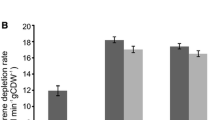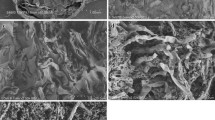Abstract
Itaconic acid is an important organic acid and a major component of various polymers. It is used in resins, superabsorbent polymers, and substitutes for petrochemicalbased monomers such as acrylic and methacrylic acids. Itaconic acid is primarily produced by the fungus Aspergillus terreus, which yields a high titer with albeit long fermentation period and by-products. In our previous study, Escherichia coli JY001 was reported to produce itaconic acid using citric acid in whole-cell reaction resulting in higher itaconic acid productivity with less by-products formation. The present study aimed to increase whole-cell enzyme stability and reusability, via immobilization of E. coli JY001 using barium-alginate beads. We optimized the cations, temperature, pH, alginate, BaCl2 concentration, cell density per bead, and CTAB content to improve transfer rate of substrates and products. Under the optimized conditions, immobilized whole cells were stable for four repeated cycles of itaconic acid production. The present results would strengthen the basis for a continuous itaconic acid production.
Similar content being viewed by others
References
Magalhães, A. I., J. C. de Carvalho, J. D. C. Medina, and C. R. Soccol (2017) Downstream process development in biotechnological itaconic acid manufacturing. Appl. Microbiol. Biotechnol. 101: 1–12.
Willke, T. and K. D. Vorlop (2001) Biotechnological production of itaconic acid. Appl. Microbiol. Biotechnol. 56: 289–295.
Robert, T. and S. Friebel (2016) Itaconic acid–a versatile building block for renewable polyesters with enhanced functionality. Green Chem. 18: 2922–2934.
Blazeck, J., A. Hill, M. Jamoussi, A. Pan, J. Miller, and H. S. Alper (2015) Metabolic engineering of Yarrowia lipolytica for itaconic acid production. Metab. Eng. 32: 66–73.
Otten, A., M. Brocker, and M. Bott (2015) Metabolic engineering of Corynebacterium glutamicum for the production of itaconate. Metab. Eng. 30: 156–165.
Crook, N. C., A. C. Schmitz, and H. S. Alper (2013) Optimization of a yeast RNA interference system for controlling gene expression and enabling rapid metabolic engineering. ACS Synthetic Biolog. 3: 307–313.
Chin, T., M. Sano, T. Takahashi, H. Ohara, and Y. Aso (2015) Photosynthetic production of itaconic acid in Synechocystis sp. PCC6803. J. Biotechnol. 195: 43–45.
Huang, X., X. Lu, Y. Li, X. Li, and J.-J. Li (2014) Improving itaconic acid production through genetic engineering of an industrial Aspergillus terreus strain. Microbial Cell Factorie. 13: 119.
van der Straat, L., M. Vernooij, M. Lammers, W. van den Berg, T. Schonewille, J. Cordewener, I. van der Meer, A. Koops, and L. H. de Graaff (2014) Expression of the Aspergillus terreus itaconic acid biosynthesis cluster in Aspergillus niger. Microbial Cell Factorie. 13: 11.
Brainard, A. P. (1999) Recent Progress in Bioconversion of Lignocellulosics. Springer Science & Business Media.
Kuenz, A., Y. Gallenmüller, T. Willke, and K.-D. Vorlop (2012) Microbial production of itaconic acid: developing a stable platform for high product concentrations. Appl. Microbiol. Biotechnol. 96: 1209–1216.
Vuoristo, K. S., A. E. Mars, J. V. Sangra, J. Springer, G. Eggink, J. P. Sanders, and R. A. Weusthuis (2015) Metabolic engineering of itaconate production in Escherichia coli. Appl. Microbiol. Biotechnol. 99: 221–228.
Okabe, M., D. Lies, S. Kanamasa, and E. Y. Park (2009) Biotechnological production of itaconic acid and its biosynthesis in Aspergillus terreus. Appl. Microbiol. Biotechnol. 84: 597–606.
Straathof, A. J. J. (2011) The proportion of downstream costs in fermentative production processes. Comprehensive Biotechnol. 2: 811–814.
Kim, J., H. M. Seo, S. K. Bhatia, H. S. Song, J. H. Kim, J. M. Jeon, K. Y. Choi, W. Kim, J. J. Yoon, Y. G. Kim, and Y. H. Yang (2017) Production of itaconate by whole–cell bioconversion of citrate mediated by expression of multiple cis–aconitate decarboxylase (cadA) genes in Escherichia coli. Sci Rep. 7: 39768.
Asgher, M., M. Shahid, S. Kamal, and H. M. N. Iqbal (2014) Recent trends and valorization of immobilization strategies and ligninolytic enzymes by industrial biotechnology. J. Mol. Catal. B Enzym. 101: 56–66.
Zhang, Y.-W., P. Prabhu, and J.-K. Lee (2010) Alginate immobilization of recombinant Escherichia coli whole cells harboring L–arabinose isomerase for L–ribulose production. Bioprocess Biosystems Eng. 33: 741–748.
Park, M. C., J. S. Lim, J. C. Kim, S. W. Park, and S. W. Kim (2005) Continuous production of neo–fructooligosaccharides by immobilization of whole cells of Penicillium citrinum. Biotechnol. Lett. 27: 127–130.
Karube, I., T. Matsunaga, S. Tsuru, and S. Suzuki (1976) Continous hydrogen production by immobilized whole cells of Clostridium butyricum. Biochem. Biophys. Act. 444: 338–343.
Roy, I., S. Sharma, and M. N. Gupta (2004) Smart biocatalysts: design and applications. pp. 159–189. New Trends and Developments in Biochemical Engineering. Springer, City.
Chan, L. W. and P. W. S. Heng (2002) Effects of aldehydes and methods of cross–linking on properties of calcium alginate microspheres prepared by emulsification. Biomaterial. 23: 1319–1326.
Chan, L. W., Y. Jin, and P. W. S. Heng (2002) Cross–linking mechanisms of calcium and zinc in production of alginate microspheres. Int. J. Pharm. 242: 255–258.
Kongruang, S. and B. Wonganu (2009) Entrapment by Ca–Alginate Immobilized Yeast Cells for Dried Longan Wine Production. Proceedings of the Current Research Topics in Applied Microbiology and Microbial Biotechnology–Proceedings of the Ii International Conference on Environmental, Industrial and Applied Microbiology (Biomicro World 2007).
Chen, R. R. (2007) Permeability issues in whole–cell bioprocesses and cellular membrane engineering. Appl. Microbiol. Biotechnol. 74: 730–738.
Baumgart, M. and M. Bott (2011) Biochemical characterisation of aconitase from Corynebacterium glutamicum. J. Biotechnol. 154: 163–170.
Steiger, M. G., M. L. Blumhoff, D. Mattanovich, and M. Sauer (2013) Biochemistry of microbial itaconic acid production. Front Microbiol. 4: 23.
Taylor, R. G., D. C. Walker, and R. McInnes (1993) E. coli host strains significantly affect the quality of small scale plasmid DNA preparations used for sequencing. Nucleic Acids Res. 21: 1677.
Acknowledgements
This study was supported by the National Research Foundation of Korea (NRF) (NRF-2015M1A5A1037196, NRF-2017R1D1A1B03033594), Research Program to solve social issues of the National Research Foundation of Korea (NRF) funded by the Ministry of Science and ICT (2017M3A9E4077234). This work was also supported by Polar Academic Program (PAP, PE18900).
Dr. Ranjit Gurav is thankful to Konkuk University, Korea for providing financial support under KU research professor program.
Consulting service from the Microbial Carbohydrate Resource Bank (MCRB, Seoul, Korea) was kindly appreciated.
Author information
Authors and Affiliations
Corresponding authors
Rights and permissions
About this article
Cite this article
Moon, YM., Gurav, R., Kim, J. et al. Whole-cell Immobilization of Engineered Escherichia coli JY001 with Barium-alginate for Itaconic Acid Production. Biotechnol Bioproc E 23, 442–447 (2018). https://doi.org/10.1007/s12257-018-0170-3
Received:
Revised:
Accepted:
Published:
Issue Date:
DOI: https://doi.org/10.1007/s12257-018-0170-3




